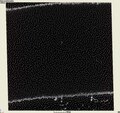Schulp
The cuttlefish ( Middle Low German cuttlefish (e) , shell (shell) '), latin Os sepium is known as "back bone" a compression stable internal floats of the Zehnarmigen squid belonging cuttlefish . Tribal History he is an internal skeleton , due to the exoskeleton shelled cephalopods (Cephalopoda).


Schulpe (Latin Ossa sepia) are often found as floating debris on the sea coast, they come from dead cuttlefish. These can also fossilize .
construction
The main material of the Schulps is aragonite (chemically a calcium carbonate , i.e. lime). Microscopically, the Schulp consists of thin aragonite plates that are supported against one another by numerous mini pillars. The formation of the fine lime structures is made possible by the mineral components being attached to the shaping chitin structures (insofar as not dissimilar to the butterfly scale). The calcification takes place in particular with increased carbon dioxide (CO 2 ) partial pressure in seawater. The build-up of the Schulps is relatively constant in time for young cuttlefish, so that the counting of the lamellae enables age-dependent examinations; however, there is no fixed time reference (such as one day per slat).
- Micro computed tomographic 3D representation
- Flights through the micro-computed tomographic image stack
Cutting plane about 30 °, side view
Section plane approx. 30 °, top view
Side view
At sight
Supervision, cutout
function
The Schulp is used for static buoyancy through gas storage. It is chambered and partly filled with gas and partly with liquid as required . The gas is supplied from the lymph via the siphunculus, which runs ventrally under the Schulp. The lamellar construction of multiple supported layers makes the Schulp a pressure-stable buoyancy body whose content and thus its relative density are controlled. The shape of the Schulps determines which depths of the sea can be reached by its wearer and in which he can stay longer.
phylogenesis
The original cephalopods were shelled organisms ( paper boats and ammonites ) with a chambered outer shell, as Nautilus still has today. In the course of evolution, this shell was first stored in the body ( phragmocone of the Coleoidea ) and was reduced more and more in later steps. The belemnites still had a large, chambered inner shell, which could be used as a buoyancy mechanism and which was weighted down with a rostrum at the rear end .
This chambered shell still exists in the ten-armed squid today, but in a reduced form. While the post squirrel ( Spirula spirula ) still has a clearly chambered phragmocone, the cuttlefish (Sepiida) schoolp is already significantly smaller, but chambering can still be seen under the microscope .
The squid have an as of the original shell only Gladius designated flat Chitinstab, which serves as an internal skeletal element. The name was given due to the shape of the structure based on the Roman short sword Gladius .
In the eight-armed squid and the vampire squid , the hard parts of the original shell have completely disappeared.

Economic use
medicine
When treating wounds, consideration is given to using ground Schulpe as a topical aid in wound healing.
Pet trade
The Schulp, formerly also known as "whalebone", is offered in the pet trade as a beak whetstone for cage birds and lime supplier for reptiles (e.g. tortoises) in terrarium and free-range husbandry .
Craft
It is also used by stonemasons to remove dried paint from polished stones and as a material for casting molds in goldsmithing. These Schulpe come from floating debris or from waste from squid processing.
Individual evidence
- ↑ Schulp bei Duden online , with further links to the etymology. Retrieved May 15, 2013.
- ↑ a b c Kristin M. Sherrard: Cuttlebone morphology limits habitat depth in eleven species of Sepia (Cephalopoda: Sepiidae). (PDF) In: The Biological Bulletin , Volume 198, No. 3, 2000, pp. 404-414.
- ↑ A. Rexfort, J. Mutterlose: Stable isotope records from Sepia officinalis - a key to understanding the ecology of belemnites? In: Earth and Planetary Science Letters , Vol. 247, Nos. 3-4, July 30, 2006, pp. 212-221. doi : 10.1016 / j.epsl.2006.04.025 .
- ↑ Wataru Ogasawara, Wayne Shenton, Sean A. Davis, Stephen Mann: Template mineralization of ordered macroporous chitin-silica composites using a cuttlebone-derived organic matrix. In: Chemistry of materials , Vol. 12, No. 10, 2000, pp. 2835-2837. doi : 10.1021 / cm0004376 .
- ↑ Magdalena A. Gutowska, Frank Melzner, Hans O. Pörtner, Sebastian Meier: Cuttlebone calcification increases during exposure to elevated seawater pCO2 in the cephalopod Sepia officinalis. In: Marine Biology , Vol. 157, No. 7, 2010, pp. 1653-1663.
- ↑ Pedro Ré, Luis Narciso: Growth and cuttlebone microstructure of juvenile cuttlefish, Sepia Qfficinalis L., under controlled conditions. In: Journal of Experimental Marine Biology and Ecology , Volume 177, No. 1, 1994, pp. 73-78. doi : 10.1016 / 0022-0981 (94) 90144-9
- ^ EJ Denton, JB Gilpin-Brown: The distribution of gas and liquid within the cuttlebone. In: Journal of the Marine Biological Association of the United Kingdom , Volume 41, No. 02, 1961, pp. 365-381. doi : 10.1017 / S0025315400023973 .
- ↑ Paul R. Austin: Wound healing compositions and formulations. US Patent No. 4,427,654. Jan. 24, 1984.
- ↑ Thomas Gleinser: Anna von Diesbach's Bernese 'Pharmacopoeia' in the Erlacher version of Daniel von Werdts (1658), Part II: Glossary. (Medical dissertation Würzburg), now at Königshausen & Neumann, Würzburg 1989 (= Würzburg medical-historical research , 46), p. 104 (“fishbones, as you need the goldschmid”).












